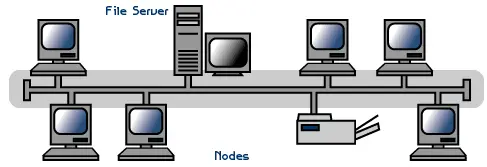- Bus topology is a network configuration in which all devices are connected to a single communication channel, called a bus. This bus acts as a shared transmission medium, allowing devices to communicate with each other.
- All devices in a bus network are linked together through a single, shared backbone cable.
- Devices attach to or tap into a single cable—the backbone—which serves as a shared communication medium using interface connectors.
- When a device wants to talk to another device on the network, it broadcasts a message onto the wire that is visible to all other devices. However, only the message’s intended recipient accepts and processes it.
- The most straightforward and widely used way to connect computers is through the bus topology. To create a full loop, the transmission line’s two ends never come into contact.
- There are several names for a bus topology, including multidrop, linear, and horizontal buses.
Key Features of Bus Topology
1. Single Communication Channel: All devices share a single bus.
2. Linear Configuration: Devices are connected in a linear sequence.
3. Termination Points: The bus has termination points at both ends.

ref:googleimage
Table of Contents
Advantages of Bus Topology
1. Easy Installation: This topology is simple to install and configure.
2. Cost-Effective: Requires less cable and hardware compared to other topologies.
3. Scalability: Can support a large number of devices.
4. Easy Expansion: Adding new devices is straightforward.
5. Reduced Cable Cost: Less cable is required compared to other topologies.
6. Simplified Network Design: This topology has a simple network design.
7. Low Latency: This topology can provide low latency for real-time applications.
8. Easy Maintenance: This topology simplifies device maintenance and repair, making it a convenient network configuration.
9. Centralized Management: This topology allows for centralized management of devices.
10. Improved Fault Isolation: This topology allows for effortless fault identification and isolation, streamlining network troubleshooting.
Disadvantages
1. Single Point of Failure: A bus failure can bring down the entire network, causing a complete loss of connectivity.
2. Limited Bandwidth: This topology can become bottlenecked with high traffic.
3. Difficult Troubleshooting: Issues can be hard to identify and isolate.
4. Limited Security: This topology is vulnerable to eavesdropping and data interception.
Limited Scalability: This topology can become bottlenecked with high traffic.
5. High Dependence on Termination: This topology requires proper termination.
6. Limited Flexibility: This topology can be inflexible when changing network configurations.
7. Vulnerability to Physical Damage: This topology is vulnerable to physical damage to the bus.
Applications
1. Local Area Networks (LANs): It is used in small LANs.
2. Industrial Control Systems: This topology is used in industrial control systems.
3. Embedded Systems: This topology is used in embedded systems.
4. Automotive Networks: This topology is used in automotive networks.
5. Aerospace Networks: This topology is used in aerospace networks.
6. Medical Devices: This topology is used in medical devices.
7. Home Automation: This topology is used in home automation systems
Comparison with Other Topologies
1. Star Topology: Bus topology is less scalable than star topology.
2. Ring Topology: Bus topology is less reliable than ring topology.
3. Mesh Topology: Bus topology is less fault-tolerant than mesh topology.
4. Tree Topology: Bus topology is less hierarchical than tree topology.
FAQs of Related Topic
1. What is a bus topology?
- It is a network configuration where all devices are connected to a single shared communication line, called a bus.
- Data travels along this bus, and each device checks if the data is intended for them.
2. What are the advantages of a bus topology?
- Simple and cost-effective: Its lower cabling needs translate to cost savings compared to alternative topologies.
- Easy to install: Straightforward setup, especially for small networks.
- Suitable for temporary networks: Can be quickly set up and dismantled.
3. What are the disadvantages of a bus topology?
- Limited scalability: Performance degrades as more devices are added due to increased traffic and collisions on the bus.
- Single point of failure: If the bus fails, the network goes down.
- Difficult to troubleshoot: Identifying and isolating faults can be challenging in a bus topology.
- Security concerns: All devices share the same communication line, potentially exposing data to unauthorized access.
4. Where is bus topology commonly used?
- Small networks: Bus topology is sometimes used in small, temporary networks where cost is a major factor.
- Legacy systems: Older industrial control systems and automotive networks may still use bus topology.
5. How does bus topology compare to other network topologies?
- This topology is known for its affordability compared to a star topology, however, it tends to be less robust and may have lower performance levels.
- While it offers simpler installation than ring topology, it’s more susceptible to disruptions when failures occur.
- Mesh topology provides greater redundancy than this topology but is significantly more complex and costly.
